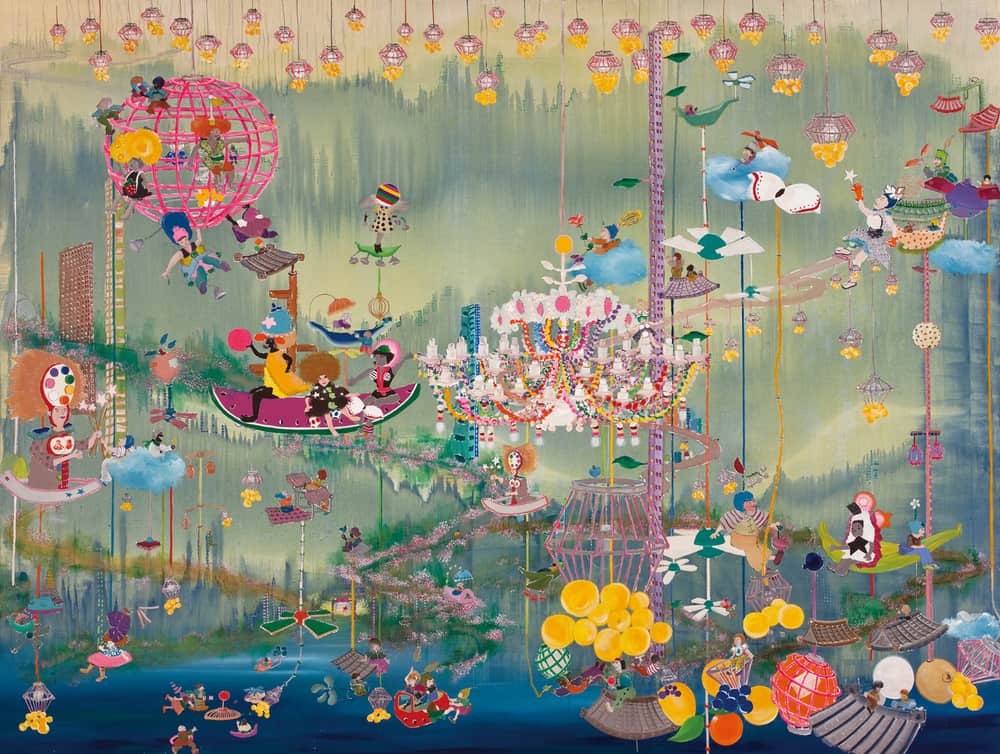- Jeongwon Yoon, 윤정원Make heaven, crylic on canvas, 194 x 259cm, 2010
- Jeongwon Yoon
- Jeongwon Yoon
- Jeongwon Yoon
- Jeongwon Yoon
- Jeongwon Yoon
The wide-ranging media of the Korean artist, Yoon Jeong-won’s work includes painting, installation, furniture, chandelier, fashion and jewellery. Her paintings are full of storybook imagery in which the kings, generals, princesses, gods, spirits, ancestors, children, and animals appear in antique dress inhabiting a fantastical landscape promising a tale of adventures of magical flight, dreams, escape and growth. In her sculptural pieces, Yoon’s works quite intuitively and her extraordinary choreography of the unexpected combinations of disparate found objects and mass-produced materials – mostly plastic – transforms these modest materials into creating magical worlds transcending the limits of time and space.
Yoon often explores her ideas as part of a series or in closely related multiples, such as the works composed of 1000 Barbie dolls or the 1000 necklaces. The painstaking laborious work and the intimidating range of scale and material retain the traces and memory of the artist’s hand. Yoon evokes humanity’s primitive experiences in order to explore the space between, the threshold, a point of transition from one state to another. Shamanic traditions of Korean culture shape Yoon Jeong won’s aesthetic sensibilities. According to Korean Shamanic practices, favorable interactions between humans and spirits are affirmed through transaction in offerings. This ‘spiritual materialism’ is a ritualized affirmation of an enduring relationship with gods and ancestors. Yoon’s plastics grafted onto ancient forms of belief and practice become the substance of dramas of ambivalence and a site for both the celebration of life and death as well as spiritual purity and material consumption – a paradox that many Koreans experience in their daily lives. Yoon conveys the whirlwind of paradox, contradiction, irrational and yet modern dynamism that resides in the modern Korean cultural landscape where contradiction equals dynamism and opportunities are created from instability, irrationality and tradition.
Drawing is a fundamental aspect of Yoon’s artistic practice – “my daily stretching exercise” – and she draws on hand-made Hanji paper by a Korean master craftsman, Lee Jong Kuk (Mabeul). Lee cultivates his own mulberry trees and vegetables in his Cheongju home garden to produce the natural raw materials used in his traditional Korean paper. The special relationship existing between Lee and Yoon began few years ago with a seed which he planted in his garden to grow the mulberry trees for her drawing papers. ‘It always begins with the paper,’ says Yoon as she explains her creative process. She starts her day with the blank sheet of paper in which she can smell the grass, soil, water, wind, and sunshine that have nourished the trees to grow. Yoon explains, “On Mabeul’s paper, I am drawing my lines in nature and in the cultural landscape he has provided for me. I get to connect to all things around me and it is a way to face the world.”
Author
 Elaine Y.J. Kim lives in Seoul where she is Deputy Director of the World Jewellery Museum. She is also Adjunct Professor of Museum management & curatorship at College of Fine Arts, Kyung Hee University
Elaine Y.J. Kim lives in Seoul where she is Deputy Director of the World Jewellery Museum. She is also Adjunct Professor of Museum management & curatorship at College of Fine Arts, Kyung Hee University
















Comments
I saw Our Time by Yoon Jungwon at San Diego museum of Art. Any posters copies for sale? What is significance of duck in center of vase?